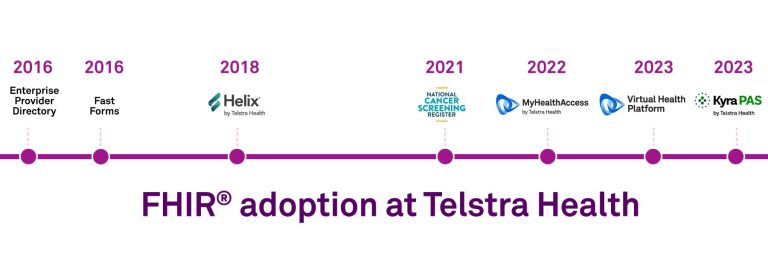Author: Jane Gilbert, Integration Lead, Enterprise Technology, Telstra Health
Fast Healthcare Interoperability Resources (FHIR) is a revolutionary open-source standard for healthcare data exchange, which is transforming the healthcare industry.
FHIR enables the exchange of healthcare information between different electronic health systems, making it possible for healthcare providers to seamlessly share patient information across different platforms and organisations. The interoperability that FHIR enables is essential for providing high-quality care to patients, reducing errors and redundancies, and improving the overall efficiency of the healthcare system. FHIR is helping to shape the future of connected healthcare.
At Telstra Health, we focus on a data-driven, rather than document-driven approach to sharing information. We believe that FHIR is core to digital connectivity across care settings which is why we have a robust program of FHIR standards adoption across our entire ecosystem of solutions, software and services.
We know that FHIR standards will not only more readily enable clinical semantic interoperability, but they also help to accelerate the opportunity for analytics and data-driven insights.
Our unique footprint connects across the broad healthcare ecosystem. The breadth, depth and scale of Telstra Health and partner solutions provides us with an opportunity to solve many complex problems that span across multiple segments or within new markets. Our enterprise vision is to enable connected healthcare solutions through timely, accessible and secure health information, built upon a foundation of common components, standards and partner capabilities.
Early adopters of FHIR
Telstra Health has been a leader in FHIR adoption since 2016, in which we used early versions of FHIR to develop the Enterprise Provider Directory (EPD). This was one of the earliest applications in Australia that was built entirely on FHIR standards.
Our EPD solution helps hospitals and large health services to centralise and manage provider, service and organisation details across multiple information systems and automatically update these with national directories. EPD is compliant with HL7 standards and has FHIR-based Application Programming Interfaces (APIs) to support current and future interoperability.
Making interoperability standards commonplace
FHIR-enabled systems are core to enabling our health system to remain sustainable in the face of the emerging trends we are seeing across the healthcare system in Australia and globally. These include:
An ageing population and growing chronic disease burden which are placing a significant strain on the healthcare system;
Barriers to accessing healthcare and workforce shortages, particularly in rural or remote areas;
Emerging technology standards, data security and the slow rollout of systems that are interoperable; and
Empowering patients to manage their own health and wellness, and the increasing appetite towards patient-based care and preventative health.
The unique challenges that surface from these trends cannot be effectively impacted at a systems level alone; they require all areas of the healthcare system to operate in harmony. And interoperability is the driving force for making this to happen.
Telstra Health is responding to these trends by embedding interoperability standards across our enhanced solutions, platforms and services. We understand the importance of enabling an ecosystem that drives interoperability and puts the patient at the centre of care.
And while legacy systems and standards in Australia are tightly embedded in the healthcare ecosystem, FHIR-enabled systems can provide a means to transform and integrate them, eventually phasing them out.


 Visit
Visit 






